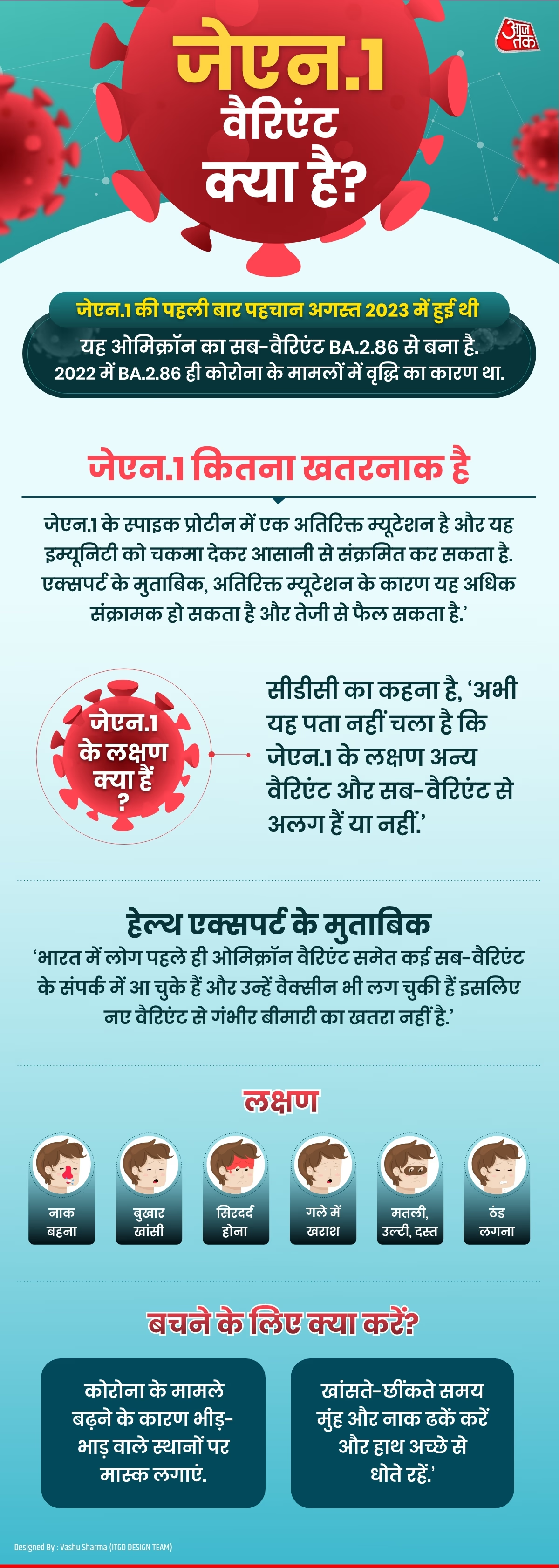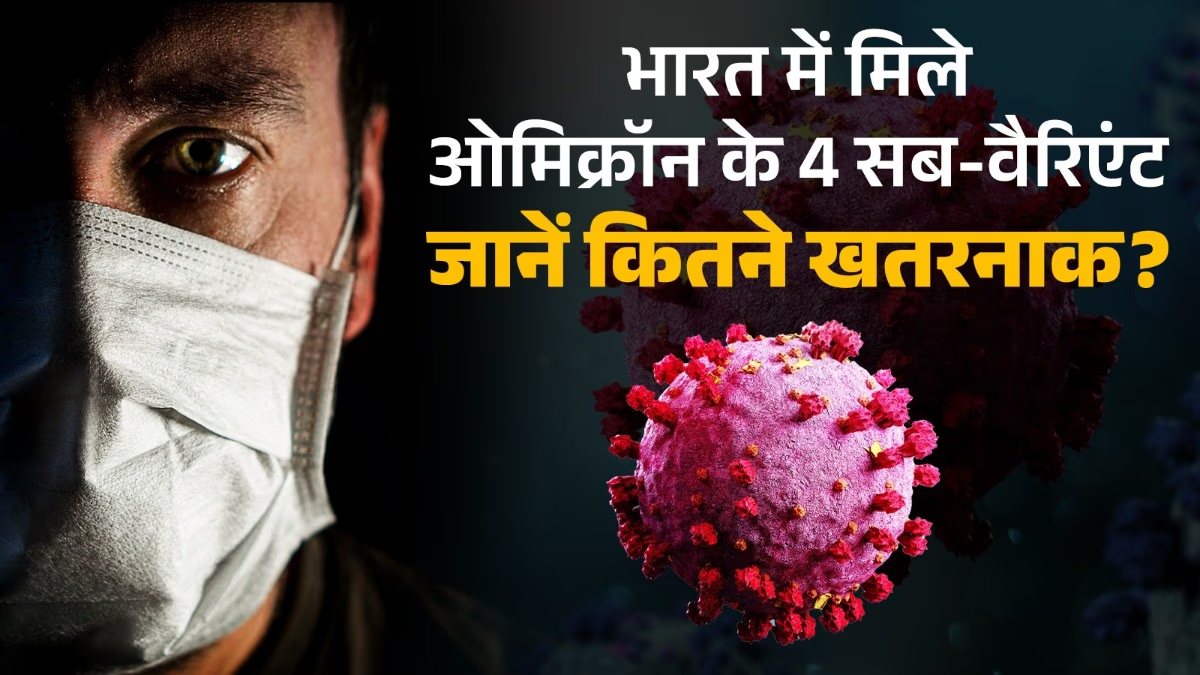COVID-19 Cases in India:
COVID-19 cases are rising once again in various parts of India. A total of 752 new cases have been reported over the past week. Delhi's Health Minister, Pankaj Singh, stated on Monday, 'The new COVID variants currently circulating are causing only mild symptoms akin to the common viral fever, and there is no cause for concern at the moment. We've advised hospitals to be prepared with beds, oxygen, essential medicines, and equipment for any situation.'
The recent spike in cases was attributed to the emergence of a new variant, JN.1, found across several states. JN.1 is a sub-variant of Omicron. However, additional variants have also emerged, contributing to the rise in cases.
Director-General of ICMR, Dr. Rajiv Bahl, mentioned, 'Surveillance is ongoing to identify reasons behind the increase in cases, and the government is making necessary preparations. The four variants identified are sub-variants of Omicron—LF.7, XFG, JN.1, and NB.1.8.1. Further investigation of samples is being conducted for more information. Outbreak control is effective, and the government is vigilant and prepared.'
'Platforms have been developed by the government for creating new vaccines. If a new variant emerges in the future, the government has two options: evaluate the effectiveness of existing vaccines and develop a new vaccine targeting the new variant.'
Let's explore the currently present variants in India.
JN.1

Source: aajtak
The rise in COVID-19 cases in Southeast Asia is primarily due to the JN.1 variant, a descendant of the Omicron BA.2.86 variant. According to WHO, the JN.1 variant has roughly 30 mutations; among them, LF.7 and NB.1.8 are the two most common variants reported in recent cases.
JN.1 cases were detected in India in early January 2024, and the same variant is responsible for increasing cases in Singapore-Hong Kong. However, details about the variants in Mumbai cases are still forthcoming.
The World Health Organization (WHO) reported that JN.1 is derived from an extra mutation in the sub-variant BA.2.86, spreading rapidly. Thus, caution is advised. Following a JN.1 sub-variant case detected in Delhi in January 2024, AIIMS noted that certain symptoms warrant urgent testing.
Experts suggest that changes in symptoms due to distinct COVID-19 variants may appear since vaccinations have been administered across India.
Many have received booster doses, and varying immune responses could lead to different symptoms in individuals. The CDC reported on 8 December 2023 regarding the JN.1 strain, indicating that symptoms' severity depends on one’s immunity and overall health.
UK health experts indicated that certain signs were reported by individuals infected with the JN.1 sub-variant, including:
Sore throat
Insomnia
Anxiety
Runny nose
Cough
Headache
Weakness or fatigue
Muscle pain
UK doctors state, 'Cough, sore throat, sneezing, fatigue, and headache are among frequently reported symptoms, though they can resemble influenza symptoms, so testing first is advised.'
NB.1.8.1
In several Asian regions, the NB.1.8.1 is linked to increased COVID-19 cases. The NB.1.8.1 appears to be spreading in parts of the world, with specific symptoms being reported, but no evidence currently suggests it causes more severe illness.
It features spike protein mutations known as A435S, V445H, and T478I, enhancing infectiousness and immune evasion capabilities.
The WHO emphasized that while NB.1.8.1 attaches more effectively to human cells, making it highly infectious, there's no evidence indicating it causes severe illness or outperforms other variants in immune evasion. It's being monitored, although not deemed hazardous yet.
Those infected with NB.1.8.1 reported symptoms similar to those of other Omicron sub-variants. These include persistent cough, sore throat, fatigue, headache, decreased appetite, gastrointestinal problems, blurred vision, nausea, or dizziness. A report highlighted a symptom associated with this variant: persistent low-grade hyperthermia (not fever). Unlike typical fever, hyperthermia involves increased body temperature without altering the body's set point, meaning the body feels warmer than usual without registering as a fever.
LF.7
LF.7 remains the most prevalent strain in India and constitutes 53% of all sequence sampling. This sub-variant is categorized under 'variant under monitoring' by WHO, indicating potential mutations impacting the virus's behavior, though not classified as 'variant of concern' or 'variant of interest' yet.
Preliminary studies and expert assessments suggest these sub-variants are more contagious, with greater potential in evading immunity than previous variants.
XFG
Insufficient information about the XFG variant exists. However, it's identified as an Omicron sub-variant. More details about its transmission capabilities will update soon after become available.
Experts assert that these are all Omicron variants and, thus far, India's overall increase and mortality rate remain low, with no major threat related to these variants. The double season (summer) this month has caused an upsurge in flu-like symptoms, overlapping with COVID symptoms. COVID has become endemic, and there's no need to worry about unseen infections.
What Risk Does India Face?
Dr. Suranjeet Chatterjee, Senior Consultant of Internal Medicine at Indraprastha Apollo Hospital, noted, 'The situation is currently under control, and there's no need to panic. Although new variant-specific vaccines aren't available yet, the existing booster offers robust protection.'
Dr. Arup Haldar, Consultant Pulmonologist at Kolkata's CMRI Hospital, adds, ‘Most cases are mild, resulting in low hospital admission rates. The increase is primarily due to weakened immunity, disparate booster coverage, and improved surveillance awareness. Vaccinations for high-risk individuals are advised promptly, continued mask-wearing in crowded areas, and adherence to basic hygiene practices are essential.’
Experts suggest high-risk individuals take booster doses swiftly, especially seniors and those with existing health issues.




